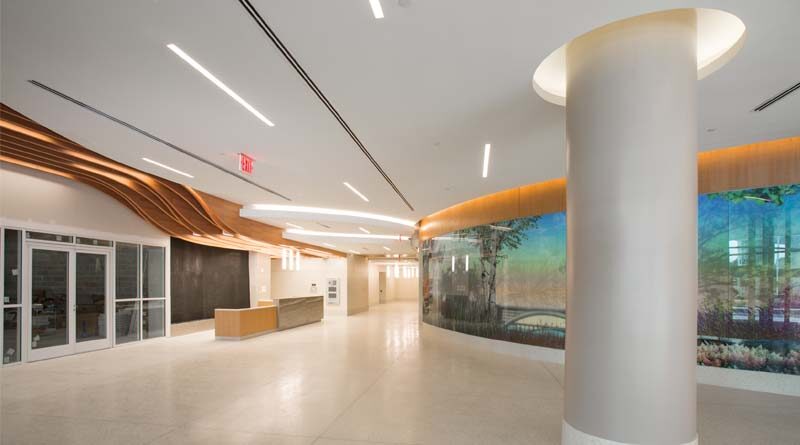Anticipating the Pandemic’s Long-Term Effect on Healthcare Design
By Guy Leibler
As we enter year two of the global pandemic, there have been transformations in healthcare delivery. Practices that were once on the periphery, such as telemedicine and touch-free check-in, have become routine even for many patients who might have resisted them in pre-pandemic times.
At the same time, health providers were forced to quickly redesign layouts of their facilities because of new requirements for social distancing. Post-pandemic, Simone Healthcare Development, as a leading developer of healthcare facilities for major medical providers throughout the Northeast, expect most health providers to convert many of the temporary social distancing measures into permanent policies.
In the short term, social distancing reminders like floor markers and hand sanitizer stations will remain. As health providers turn to longer-term and more expensive social-distance solutions, we will see an overhaul in waiting room design, as providers replace old furniture with seating that is easy to reconfigure, clean and disinfect. Waiting rooms may also expand, as the need to accommodate safely distanced patients continues and many physicians are permitting patients to wait in their cars and call when “the doctor is ready.”
In future construction or renovations, we may see buildings with wider hallways or multiple, one-way hallways with doors or turnstiles that only permit one-way entry or exit. More examination rooms and waiting rooms will become negative pressure environments. The need for negative pressure will require enhanced ventilation systems with new air-filtering technologies.
Despite adjusting to these new realities, many providers face the continuing challenge of consolidating a number of medical practices into one multi-specialty location to benefit patients and medical staff, create efficiencies and provide seamless care. The challenges of such projects are complicated but achievable, and we expect this consolidation trend to continue for the foreseeable future.
A good example is a medical practice consolidation project successfully completed by Simone Healthcare Development for the Mount Sinai Health Network. When assigned by Mount Sinai Long Island Doctors to find a location for a building that would consolidate their many practice units in the Huntington, Long Island area, Simone Healthcare Development took on the challenge. Simone Healthcare led the effort to source and acquire the property, secure approvals for zoning, site plan, and change of use to a medical office building for 5 Cuba Hill Road in Greenlawn, N.Y. Now in full operation, this Mount Sinai Long Island Doctors location will have 200,000 patient visits per year, clear proof of its value to the community.
The consumer push to lower medical costs will also continue, causing a proliferation in out-patient services and medical procedures. A growing aging population is also driving profound change. Today there are 50 million people in the United States over the age of 65. In the next 10 years alone, the over 65 population is going to grow by 20 million people. We must become more efficient and effective in treating this aging population.
As an example, by 2030, the number of primary total knee replacements is expected to increase by 673% to 3.48 million procedures annually, and the number of primary total hip replacements will increase by 174%, to 572,000 procedures annually. As the population ages, more people develop arthritis of their joints and problems with their spines. We are now more active in the later years and sustain similar injuries of younger people. Osteoporosis which affects older men as well as older women, leads to an increase in fractures, especially in the spine and hips. Each year, approximately 300,000 people fracture their hips because of osteoporosis.
To accommodate the growing preference for day surgeries and avoiding hospital stays, the trend toward the “bedless” hospital continues as well, such as the facility that Simone Healthcare built for Montefiore Medical Center in the Bronx where a patient arrives for a procedure in the morning and leaves later in the day. Continuing strides in technology and healthcare now require a lot less patient recovery time.
The concept of ambulatory care is taken to new heights with this 280,000-square-foot “bedless hospital” custom designed for Montefiore Medical Center. Located at the Hutchinson Metro Center campus, the 11-story tower includes 12 operating rooms and four procedure rooms, an advanced imaging center, onsite laboratory services and pharmacy, as well as new primary and specialty care practices. From the moment you enter the elegantly designed lobby, you sense a healing environment that provides patients with a positive experience while offering an array of medical services in a central location including primary and specialty care visits, diagnostic imaging and surgery. The interdisciplinary approach to care — with doctors, nurses and technicians all located on the same floor — allows for stronger, easier collaborations and referrals.
Another of today’s most important technology trend is how Artificial intelligence (AI) will transform how healthcare is delivered. He said AI will help increase productivity and the efficiency of care delivery and allow healthcare systems to provide more and better care to more people.
In addition, the huge growth under way in biotech and life sciences will have tremendous impact on healthcare. Outpatient and urgent care facilities will continue to grow, as will the use of telemedicine.
Meeting the challenges of future healthcare delivery requires a close and trusting relationship between developer and healthcare provider and a shared future vision of excellence in healthcare delivery. At Simone Development, we welcome this transformation in healthcare delivery because all patients deserve peace of mind when seeking essential care and preventive medicine.
Guy Leibler is the president of Simone Healthcare Development.

